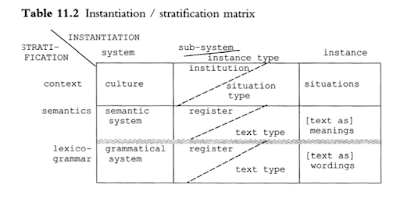Register analysis then gives us another way of thinking about context, alongside genre. The main difference is that register analysis is metafunctionally organised into field, tenor and mode perspectives whereas genre analysis is not. For us the relationship between the register and genre perspectives is treated as an interstratal one, with register realising genre (as in Figure 9.2). The relationship between register and genre in other words is treated as similar to that between language and context, and among levels of language (as outlined in Chapter 1).
Blogger Comments:
[1] To be clear, Martin & Rose model culture as varieties of language, genre and register, and do not model these varieties of language as language. This latter is analogous to not construing types of fruit as fruit.
Moreover, modelling varieties as stratal systems sets up a theoretical inconsistency with other strata, including their own discourse semantics, because other strata are not varieties, but full systems.
In SFL Theory, these varieties of language, text type (genre) and register, are the same phenomenon viewed from opposite poles of the cline of instantiation: text type (genre) is the view of register from the instance pole, whereas register is the view of text type (genre) from the system pole.
[2] To be clear, in SFL Theory, field, tenor and mode are the metafunctional system of context, which the authors' have misconstrued as register, a functional variety of language. In SFL Theory, different configurations of these contextual features are realised by different registers of language.
[3] To be clear, the fact that the authors' model of genre is not 'metafunctionally' organised is yet another dimension of theoretical inconsistency, since, not only are all other strata 'metafunctionally organised', but the metafunctions are a central tenet of SFL Theory.
As previous posts have demonstrated, from the perspective of SFL Theory, the authors' notion of genre is a confusion of different dimensions of the theory. For example,
- their 'genre' is text type, which is register viewed from the instance pole of the cline of instantiation;
- their 'generic purpose' is a culture stratum system, language rôle, within the textual system of mode;
- their 'generic stages' are semantic stratum units, oriented to mode.





